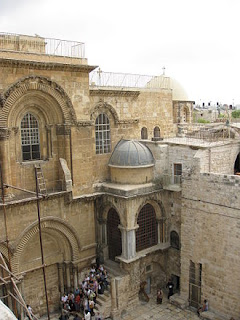Fulk, King of Jerusalem. aka known as Fulk the Younger, was the Count of Anjou (as Fulk V) from 1109-1129 and King of Jerusalem from 1131 to his death (1143). During his reign, the kingdom of Jerusalem reached its largest territorial extent. When he married Ermengarde of Maine, the Angevin control over the County of Maine was cemented. He was originally an opponent of King Henry I of England and a supporter of King Louis VI of France, but around 1118 he allied himself with Henry when he arranged for his daughter Matilda to marry Henry’s son and heir, William Adelin. Fulk went on crusade around 1119, and became attached to the Knights Templar. He returned, late in 1121, after which he began to subsidize the Templars, maintaining two knights in the Holy Land for a year. Much later, Henry I. arranged for his daughter Matilda to marry Fulk’s son Geoffrey.
 |
| Kingdom of Jerusalem 1135 AD |
Crusader and King.
By 1127 Fulk was preparing to return to Anjou when he received an embassy from King Baldwin II of Jerusalem; who had no male heirs but had designated his daughter Melisende to succeed him; to safeguard her inheritance by marrying her to a powerful lord. Fulk was a wealthy crusader and experienced military commander, and a widower. His experience in the field would prove invaluable in a frontier state always in the grip of war. Fulk abdicated his county seat of Anjou to his son Geoffrey, married Melisende 6/2/1129; when Baldwin II died in 1131 they became joint rulers of Jerusalem.
Death. Fulk was killed in a hunting accident; his horse stumbled, fell, and Fulk’s skull was crushed by the saddle, he was carried back to Acre where he died. He was buried in the Church of the Holy Sepulchre in Jerusalem. Note (Jody Gray): there is an Acre, Outrerner, Levant, in North Dakota and Kansas, Maine (where Fulk, King of Jerusalem died)...
Family.
1110, Fulk married Ermengarde of Maine (she died 1126), daughter of Elias I of Maine. They had four children. 1. Geoffrey V of Anjou (1113-1151), father of Henry II of England. *he married (Empress) Matilda, daughter of Henry I. 2. Sibylla of Anjou (1112-1165, Bethlehem), married in 1123 William Clito (divorced in 1124), married in 1134 Thierry, Count of Flanders. *William Clito, son of Robert, Duke of Normandy, grandson of William I, the 1st Norman King of England. 3. Matilda d’Anjou (1111-1154, Fontevrault), married William Adelin *son of William I, drowned in the White Ship disaster of 1120, she became a nun and later Abbess of Fontevrault. 4. Elias II of Maine (died 1151). His 2nd wife was Melisende, they had two children: 1. Baldwin III of Jerusalem 2. Amalric I of Jerusalem.
The Church of the Holy Sepulchre aka the Church of the Resurrection or Church of the Anastasis; located in the Christian Quarter of the Old City of Jerusalem. The church contains, according to traditions dating back at least to the fourth century: the site where Jesus of Nazareth was crucified, known as “Calvary”, and Jesus’s empty tomb, where he is said to have been buried and resurrected. The tomb is enclosed by the 18th-century shrine, called the Edicule… The church has been a major Christian pilgrimage destination since its creation in the fourth century, as the traditional site of the Resurrection of Christ, thus its original Greek name, Church of the Anastasis.
Today the wider complex accumulated during the centuries around the Church of the Holy Sepulchre also serves as the headquarters of the Greek Orthodox Patriarch of Jerusalem, while control of the church itself is shared between several Christian denominations and secular entities in complicated arrangements essentially unchanged for over 160 years, and some for much longer. The main denominations sharing property over parts of the church are the Greek Orthodox, Armenian Orthodox, Roman Catholic, and to a lesser degree the Egyptian Copts, Syriacs and Ethiopians. Meanwhile, Protestants including Anglicans have no permanent presence in the Church and they generally prefer the Garden Tomb, elsewhere in Jerusalem, as either the true place of Jesus’ crucifixion and resurrection, or at least a more evocative site to commemorate those events.
Construction.
According to Eusebius of Caesarea, the Roman emperor Hadrian in the 2nd century AD built a temple dedicated to the goddess Aphrodite in order to bury the cave in which Jesus had been buried. The first Christian emperor, Constantine the Great, ordered in about 325/326 that the temple be replaced by a church. During the building of the Church, Constantine’s mother, Helena, is believed to have rediscovered the “True Cross,” which tradition holds that when she found three crosses she tested each by having it held over a corpse and when the corpse rose up under one, that was the true cross, and a tomb (although there are some discrepancies among authors). Socrates Scholasticus (born c. 380), in his Ecclesiastical History, gives a full description of the discovery.
Other References
http://www.findagrave.com/cgi-bin/fg.cgi?page=gr&GRid=11784872&ref=acom Find A Grave: Fulk of Anjou, V.
Blog Post: Norman Kings of England, 1066-1154.


No comments:
Post a Comment
Note: Only a member of this blog may post a comment.